At BikeExchange, it’s no surprise that we love biking. We want to be on our bikes as much as possible. Since we do so much biking for fun — whether we’re riding through the bush or trying to set a personal best on a long distance road route — why wouldn’t we want to bike to work?
But commuter biking is much more than a fun experience. It’s healthier both for you and for the planet, and it’s easier on the hip pocket. If you’re interested in getting into commuter biking, we want to make it as easy as possible for you to take the leap. That’s why we’ve compiled some of our best advice for getting started. Included is some wisdom about picking the best commuter bikes, all the necessary accessories and all the essential biking clothes.
We’ve also collected some essential tips on planning your route, keeping your bike in peak shape, and being safe while you travel.
We know the joys of biking, so why shouldn’t you? Follow this guide and you’ll find that you love the sport as much as we do!
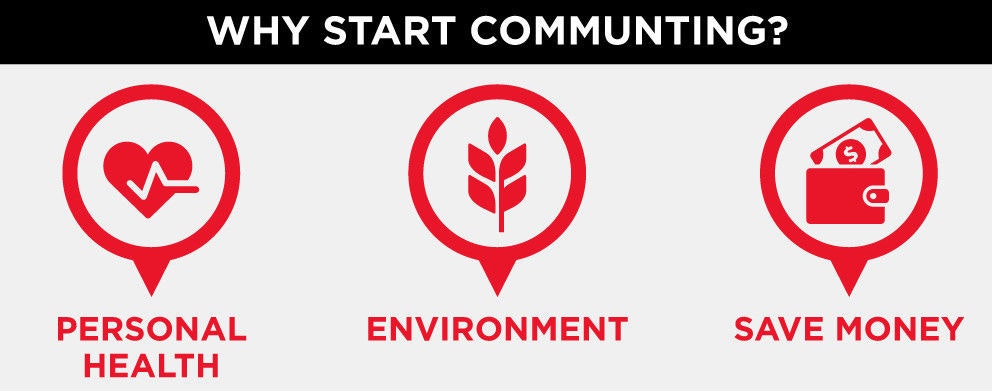
Why Start Commuting?
Before we start covering the different bicycle styles and accessories best suited for commuter biking, we want to cover the many benefits of taking up commuter biking.
Here are a few reasons for keeping your car in the garage and taking a bike to work instead:
Personal Health
Being a fit person is strong motivation for taking up biking to work. Considering the cost of fitness centers, opting for an excellent cardio workout without paying gym dues is a no-brainer. Biking gets your heart rate up and helps you burn calories without putting stress on your joints like running does. Rather than carving out valuable free time to run on a treadmill, build your workout into your morning commute.
Studies have shown that those who bike to work take fewer sick days and are more productive when they are at work. You could even investigate if your place of employment offers incentives for commuter biking.
But biking to work does more than just burn calories: It is a great way to maintain mental health as well. As people spend more time in front of screens, work/life balance becomes increasingly harder to maintain. Biking gives you the opportunity to take time away from worrying about meetings or emails.
Environment
In a world slowly being choked by the use of fossil fuels, a focus on human power rather than carbon-emitting petrol is a great way to positively impact the environment. But that positive impact extends beyond your personal choice to avoid driving to work.
As more people choose to get their cars off the road, urban traffic becomes manageable. Cars stuck in crawling traffic burn more petrol, thus increasing their carbon footprint. By doing your part to ease traffic problems, you are not only reducing your own carbon emissions — you are helping everyone else burn fewer fossil fuels.
Save Money
Cars are expensive. Public transport passes are cheaper, but require a regular investment. After you purchase your bike and any other necessary equipment, bike commuting is free. Combined with the money saved on gym memberships, biking is the most cost-effective way to commute.
If you are trying to save money to start a family, buy your dream home or pay down your credit, biking to work is a great way to cut expenses from your budget.
Picking the Best Bike
The first step in getting ready to commute to work is picking your bike. Considering your biking needs and desires, you may want a traditional road bicycle, a mountain bike or a chic traditional bike. All have their advantages and disadvantages.
Take some time to think about what kind of biking lifestyle you want so that you can pick a bike accordingly. We carry the best city bikes here at BikeExchange, so regardless of what style you prefer, we’re sure to have it available!

Road Bikes
Road bicycles are made for speed. Their thinner wheels and sleeker design are fast but don’t handle bumps and rough terrain well. Their design reflects the racing mindset of the Tour de France but is also an excellent choice for a bike commuter.
Road bikes come with a wide range of handlebar styles, from the traditional curved handles to the straight handles more commonly associated with mountain bikes. They also can be built from a variety of materials, from aluminium to the ultra-light carbon fiber
If you have a need for speed or just want to get to work with the least amount of wind resistance, you should definitely check out a road bike.
Mountain Bikes
Mountain bikes have flat handlebars and rugged tires. They are designed to traverse any type of terrain. They have a wide range of gears and often come with shock absorbers in order to help riders navigate difficult routes.
However, while these bikes may be designed for off-road use, they can handle everyday bike riding just as well. They are great for quick turns, so if your commute to work zig-zags through the city, a mountain bike might not be a bad idea.
If you’re the rugged type, the kind that likes adventure and taking the road less traveled, consider a mountain-style commuter bike.
Traditional Rides
These are the stylish bicycles that are primarily for show. They aren’t designed to tackle the trails or make long excursions into the bush, nor are they the fastest bikes on the bitumen. But they are stylish and perfect for the commuter who wants to get noticed on their way to the office.
But that doesn’t mean that these bicycles aren’t high quality. They are designed for comfort, with well-cushioned seats for a gentle ride. You can also trick out with a basket or a bell.
This is the perfect bike for the hipster who wants to cruise about town in style. They may not be the fastest and they won’t survive a trek down a mountain, but they look good, and sometimes that’s all you need.
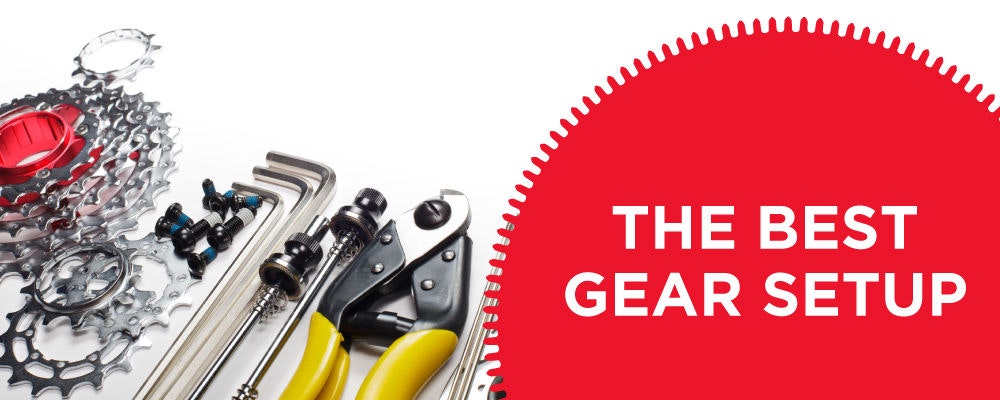
The Best Gear Setup
Now that you’ve selected the perfect style bike, you should take some time to consider the best gear setup for your commute.
The theory is pretty simple: The more gears, the better you can adjust to different riding conditions. But more gears also mean more potential problems, as added gear wheels mean more moving parts. You need a balance between simplicity and a terrain-appropriate setup.
If you live in a hilly city or want to ride your bike in a lot of different situations, you should have a wide range of gears. The same is true if you know you’re going to be carrying a lot of cargo while you’re biking as well. These wide-range geared bikes typically have triple chain-rings.
If you are going to do most of your biking on even surfaces, you might want to consider a double chain-ring gear set up. You’re still able to drop into low gear for hills, but you won’t have access to the lowest and highest gears, taking away a few steep hill and high-speed options. This setup is easier to maintain, so if you won’t miss those added gears then they aren’t worth the headache.
Essential Accessories
Once you have your perfect bike picked out, you want to pick up the necessary accessories. These vary depending on how you ride and what you need to bring with you to work, but some are essential regardless of what kind of rider you are.
Keep these accessories in mind as you prepare yourself for your commute:
Lights
In almost every state bikes needs to be equipped with two lights; one white light on the front and a red light on the back. These must be visible from 200 yards. This is an essential safety feature and an inexpensive addition. Blinking lights make you easier to see while illuminating lights help you see the path ahead if you’re riding in the early morning or late in the evening.
There are a number of lights you can choose from, so make sure to think about how you plan to ride and pick the best light accordingly.
Handlebar Mirrors
Considering the number of obstacles in most urban commutes, handlebar mirrors are a handy feature. They’ll help you see your surroundings so you can navigate your commute safely. They are inexpensive and easy to install, so they aren’t a tough addition.
Just make sure that you pick mirrors that fit with your style of bike. Your bicycle might come with a recommended mirror style, making the choice easier.
Mudguards
When biking in the rain, the worst mess comes not from overhead but from below. As wheels traverse the wet bitumen, they kick up rain and mud.
Mudguards help keep you dry and mud-free. They even protect your drive train from getting gunk on it. For the urban commuter, these are a must, because even if the rain has passed a wet road can still leave you a mess.
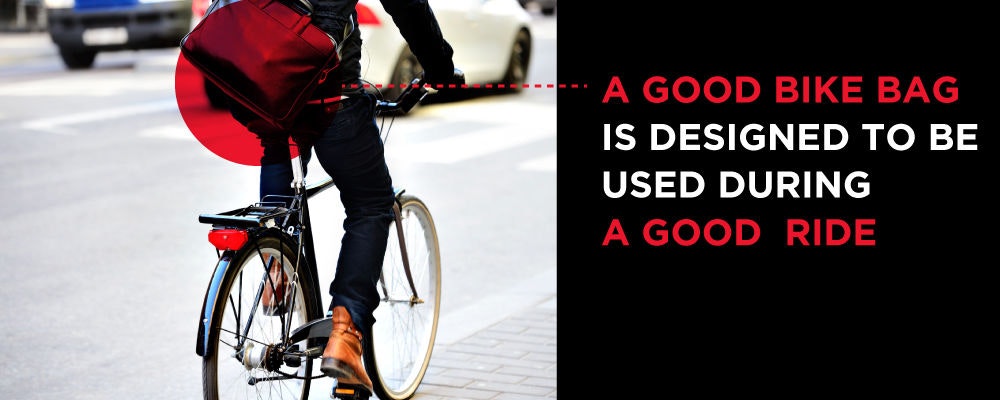
Bike Bags
If you’re commuting to work, you likely need to bring more than just your body to the office. A good bike bag, designed to be used during a ride, helps you carry what you need to work comfortably and safely.
A wedge bag can be attached to your bike, giving you some cargo space. Rack bags are larger but some might find their bulk uncomfortable. Pannier-style bags offer the most storage but some people find them harder to balance due to the added weight.
Of course, messenger bags are designed to be used while riding. Just make sure that you wear your bag high on your back. A slouchy messenger bag may be more fashionable, but it can be unsafe during your ride. And finally, a traditional back-pack is a time-honored method for carrying what you need in a sporty and fashionable way.
Bike Locks
Like a helmet and a light, a bike lock is an absolutely essential accessory. Because commuting requires an initial investment, you would hate to see someone snatch your bike because it was sitting unlocked on the street. You’d be surprised how quickly a bike can go missing: make sure to lock your bike up every time it is left outside, even if only for a minute.
We highly recommend a U-style lock. These are harder to cut through and are the best at deterring would-be bicycle thieves. Regardless of the style, a lock is far more affordable than replacing a stolen bike, making this purchase a no-brainer.
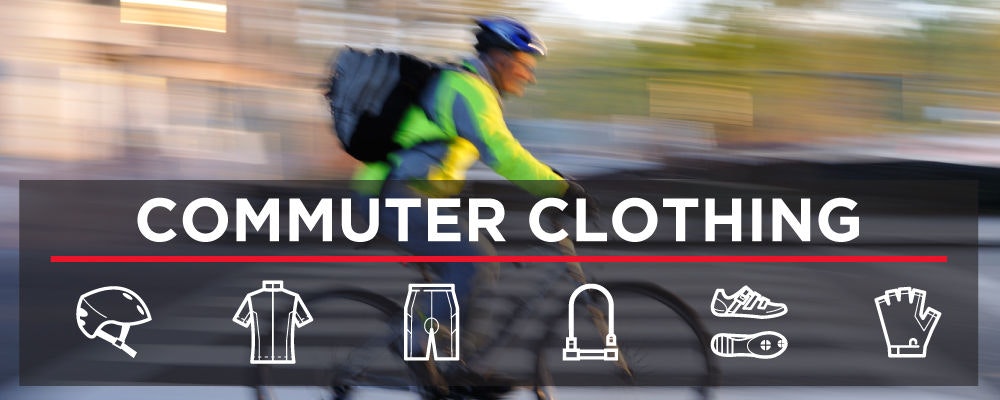
Commuter Clothing
The appropriate clothing for biking to work depends on the way you ride and the distance of your commute.
If you are just a few km away, you may be fine commuting in street clothes with just a few safety conscious modifications. But if you are a committed cyclist who isn’t scared to bike into the city from the suburbs, then you likely want dedicated bike clothes to ensure you are both comfortable and safe during your trek.
With that in mind, here are the basic necessities for every commuter, followed by a few specialty clothing items for those with long commutes:
Helmets
This should go without saying, but here in Australia, riding without a helmet is illegal. If you only add one thing to your commute outfit, it should be a helmet. They save lives and no one should be on a bike without one.
Thankfully, bike helmet manufacturers have kept the style-conscious commuter in mind and provide a wide range of helmets. Finding a helmet that fits your style is easy — just make sure that you are buying it new. You should always replace your helmet after any sort of accident and you might not know the history of a used lid. A new helmet guarantees that it meets the requisite safety standards.
Sunglasses
Light conditions can change quickly, especially if you suddenly move out of the shade from a nearby building. If you are commuting during the day, it is recommended that you have a decent pair of sunglasses. Specially designed bicycle sunglasses make seeing easier under a variety of conditions. And like helmets, they come in a variety of styles, so you won’t have to sacrifice your look.
Pants Protectors
If you are commuting in your work pants, you want to make sure you get to the office without covering your pants in bike grease. A pants protector gathers your pants away from the gear wheels, making sure that they don’t come in contact with the gear works.
This is also an important safety accessory, as getting your pants tangled in the drive train can cause your wheels to lock up, leading to a nasty crash.
You only need one protector, as just one leg is on the same side as the gear wheel.
Cycling Gloves
Cycling gloves may seem like a luxury, but if you are biking with any regularity, you quickly find that gloves make the commute easier and more comfortable. They help keep hands warm in cold weather, absorb road vibrations, making your commute less draining on your arms. In the unfortunate event of an accident, they are also essential for helping you avoid nasty abrasions on your hands, not to mention helping to protect you from sunburn during your warm weather commutes.
Gloves come in both fingered and fingerless varieties, and include good grip and padding in the palm. We recommend having a summer pair and a winter pair to make your commute a little easier on your hands.
Waterproof Jacket
If you’re committed to all-weather commuting, you want a good waterproof jacket to keep you dry on rainy days. But these wind resistant jackets are also a good idea on dry days, as they’ll help keep all of a city’s messy surprises off of your work clothes.
Bike jackets come with reflective elements, making them a nice safety feature as well.
Cycling Vests/ Gillets
In the warmer months, you may not want a full jacket. A cycling vest or a gillet is a good compromise. Like a jacket, it is reflective and waterproof, giving you a certain amount of protection from the elements while contributing to safer cycling.
Bike Shorts
Now we’re getting into more specialized clothing accessories. But if you have a long commute, a pair of padded bike shorts might feel like a necessity. They are more comfortable as they give you more padding on your seat while also preventing chafing and other bike related discomfort.
Plus, wearing a pair of dedicated shorts helps keep your work attire more presentable once you reach the office.
Base Layers
If you plan on cycling in cold weather, a good base layer helps keep you warm without adding bulk or restricting your movement. And if you’re style conscious while you commute, base layers can easily fit under any clothes you might have.
Cycling Shoes
Depending on your commute and the intensity of your ride, you may want to get a good pair of cleated cycling shoes. These shoes attach to your pedals so that you can get as much cycling power out of lifting your foot as you do pushing down.
But even if you don’t need cleated shoes, you should always ride with a good rubber sole. You don’t want to destroy your nice leather shoes on your way to work.
Cycling Caps
Most cycling caps are designed to fit under a helmet. If you want to wear a hat to protect your hair or keep sweat out of your eyes during your ride, these are a nice accessory to have.
Taking the Safest Route
There are probably a number of possible routes between your home and work. But just because a route is the quickest doesn’t mean that it’s the best. Getting to work safely is more important than getting there quickly.
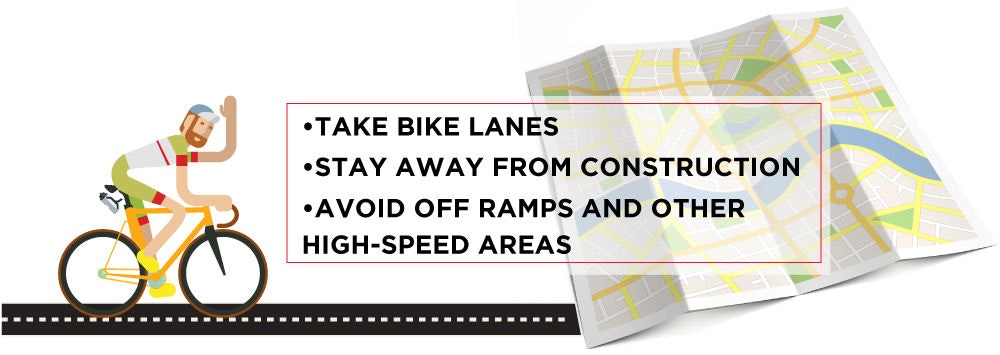
Keeping that in mind, we offer these quick tips for planning the safest route to work:
Take Bike Lanes
As cities come to learn the benefits of supporting their biking population, they are creating designated bike lanes on the street. These lanes are designed to keep cars and bicycles separated, which is safer for both.
But some streets are just too narrow or regularly congested to accommodate a designated bike lane. Do some research on your route and pick a route that avoids streets without bike lanes.
Stay Away From Construction
While road construction is typically properly marked with warning signs, these warning are often designed with car travelers in mind. The space between cones can be wide or hard to see when biking. Stumbling into a construction zone can be incredibly dangerous for a biker.
Light construction debris isn’t a big deal for cars, but an unexpected patch of gravel can easily cause bike tires to lose their grip on the road. You don’t want to lose control. If you know there is construction on your normal route, consider taking a detour. It may take you a little longer, but it’ll be worth it to avoid the potential hazards.
Avoid Off Ramps and Other High-Speed Areas
Obviously you won’t be commuting on the freeway. But you also want to try and avoid those areas where drivers are exiting the freeway, often still at high speeds.
Also, avoid the portions of roadway where the speed limit is much higher than normal urban roads. These are places designed to allow drivers to commute more quickly, and drivers tend to be less aware of bikers on the road.
These high-speed areas aren’t as useful for bikers: Unlike the drivers, you won’t be going any faster than normal. Stick to the slow-paced roads where biking is more common. Drivers should be expecting you to be there and be more mindful of you and your commute.
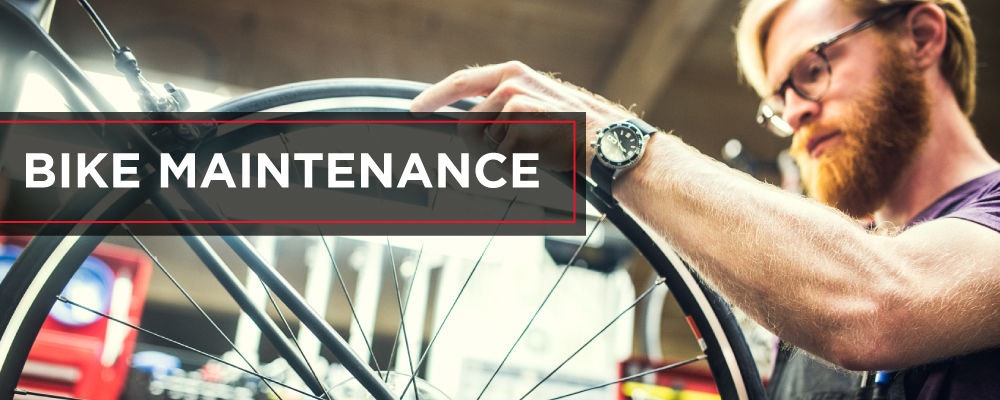
Bike Maintenance
Biking is a fun way to stay active while transporting you efficiently. But sometimes your ride breaks down, and that’s not fun at all. If you want to stay on the move, make sure you’re familiar with the basics of bicycle maintenance. While you should definitely turn to a professional for big repairs, fixing minor problems yourself saves you both time and money.
Here are a few minor maintenance routines and repairs you should become familiar with before you start commuting regularly:
Keep Tires Properly Inflated
No matter good a quality your tires are, they slowly lose air naturally. You may not notice the change in tire pressure at first, but over time, your ride grows sluggish as your flat tires struggle under the weight of your bike.
Make sure you are checking your tire pressure regularly: at least weekly, if not more frequently. If you have a floor pump that has a pressure gauge on-board, checking and refilling your tires to the proper pressure is easy.
Get Oil on Your Gears
Gears work better when they are properly lubricated. Shifting and pedaling is easier if the entire drive train is oiled regularly. Once or twice a month apply some chain lube. Be generous and let it set for a while. Come back with a cloth and wipe off any extra oil.
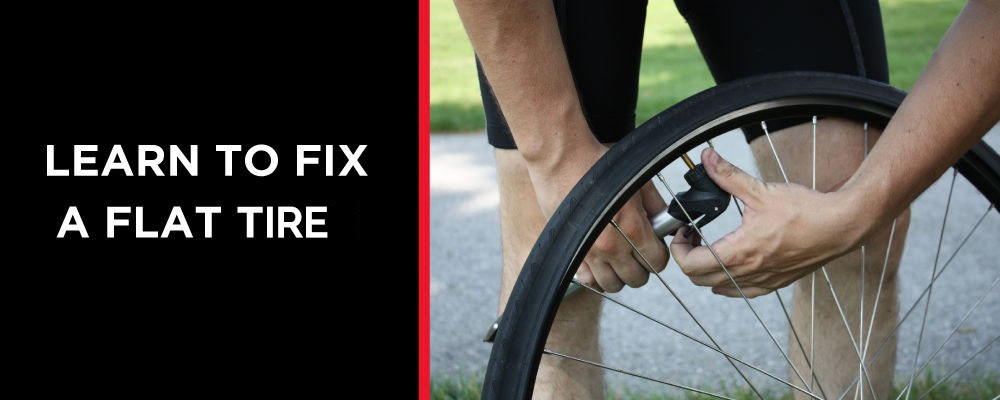
Learn to Fix a Flat Tire
The most common problem plaguing bikers is the dreaded flat tire. Any number of hazards can puncture a tire, leaving you stranded along your route. Commuters hate flat tires more than mere biking enthusiasts, as a flat ensures they’ll be late to work or stuck away from their much-needed end-of-day relaxation.
For a start, make sure your tires are outfitted with liners complete with sealant. If your tire suffers a minor puncture, the sealant fills the hole and keep your wheel from going flat. It won’t be a permanent fix, but it’ll allow you to get to your destination safe and give you time to properly fix the tire.
If the flat is more serious, you should [know how to fix it yourself. Make sure you have a couple of tire levers, a hand pump, a spare tube, and a patch kit on hand.
In the case of a serious wheel failure – for instance a broken spoke – you need to know who to call so you can get to work safely and on time. A backup plan saves you a long walk and an angry boss staring at her watch.
Give Your Bike a Routine Check-Up
While you should be familiar with basic maintenance, it is also helpful to take your bike into a reputable repair shop regularly. If you take your bike in once a year, you can catch serious problems before they strand you on the side of the road. Plus they are able to take your bicycle apart completely, clean every part thoroughly, and then put it back together, making sure everything is tight and in optimal working order.
Being a Safe Rider
At the end of the day, all the best equipment in the world won’t protect you if you aren’t a safe rider. Some of these tips may seem obvious, but you’d be surprised how many people ignore basic common sense while they’re on their bikes. Not only is biking dangerously a hazard to your health, but it can put pedestrians, drivers, and other riders at risk as well.
Follow these quick tips to ensure you bike safely:
Follow the Rules of the Road
When you’re commuting on your bike, you are still subject to traffic laws. Riding a bike doesn’t mean you can run through red lights or stop signs. If the light is red, come to a complete stop and wait for it to turn green. Come to a complete stop at a stop sign.
Be sure to travel in the same direction as the traffic. Riding against traffic is dangerous, as it gives drivers far less time to react to you. So if you’re on a one way street, which is common in cities, make sure you’re going the correct direction.
Respect Pedestrians
Bikers rightfully demand respect from drivers. In a crash between a car and a bike, the car always wins. By that same logic, you need to respect pedestrians. They are trying to get to where they need to go safely, just like you.
Avoid riding on footpaths, unless it is a specially designated bike lane. And when you stop at a light, don’t block the pedestrian crossing.
Use Turn Signals
If you are turning, let people know. Signal by extending your arm in the direction you plan to turn. If you are braking, raise or lower your bent right arm in a kind of right-angle shape, and either close your fist or create a stop signal with your open hand. Although this signal is somewhat open to everyone adopting their own style, the interpretation is always the same – it means you are stopping. This helps cars and other bicyclists anticipate your movements.
Carry a Paper Map
A lost rider is generally less safe, as they are more focused on finding their way than watching the road ahead of them. While Google Maps makes finding your way around easier, sometimes the phone dies.
It’s a good idea to always have a small map of your city on hand in case of an emergency. Pull over and figure out where you want go so you can focus on riding when you are on your bike.
Ignore Aggressive Drivers
Everyone knows some drivers are bad drivers, and somewhat anti-cyclist. The more justice-minded of us might feel we should teach these people a lesson. Unfortunately you are far more vulnerable on your bike than they are in their car.
Nothing is going to be accomplished by picking a fight with a dangerous driver. In fact, it only makes things worse. We know that the best approach on the school yard is to stand up to bullies, but your commute isn’t the time or the place. Take a deep breath and let the bad driver pass.
If it makes you feel better, say all the terrible things you want about that person in your head. But arriving safely is more important than winning an argument with a dangerous driver.
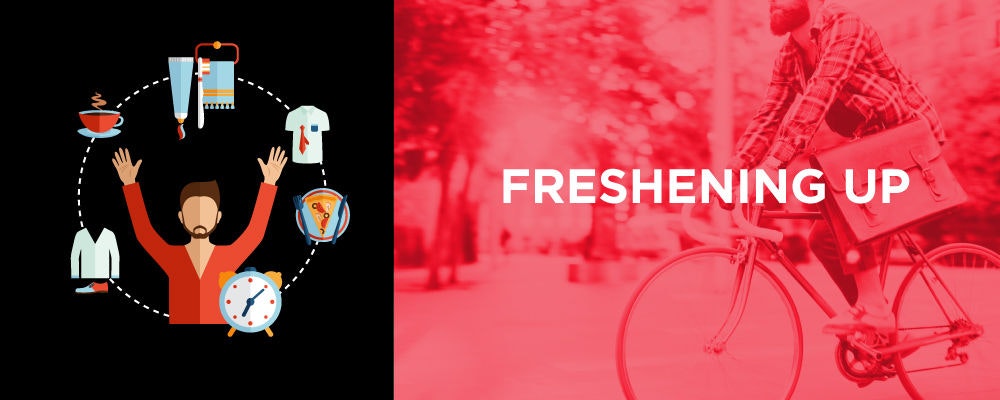
When you get to work, you might be sweaty. While that’s a sign of a good work out, it’s not great for a meeting in a conference room. But thankfully, we usually think freshening up is more involved than it really is.
If your employer provides shower facilities or has an on-site gym, you can just save your morning grooming for after you arrive. But if they don’t, there are a few steps you want to take to make sure you’re presentable.
To start, don’t wear your work clothes on your ride if you know you’re going to be sweating. Instead, head into a stall in the bathroom and change after you get to work. Just wait a few minutes so that you stop sweating.
When you do change, take some wet wipes with you. But make sure they are either lightly scented or at least smell nice enough to put on your whole body. A quick wipe helps you feel fresh again. And of course, reapply your deodorant to make sure your underarms aren’t stinky.
You should also consider keeping necessary hair products with you at work. That way you can reapply your product so you don’t have helmet head.
Add a couple spritzes of cologne or perfume and no one knows you didn’t drive in like everyone else.

Enjoy Commuting!
Hopefully this guide has proven useful. We love biking and we want everyone else to love it too. We know that biking to work is a great way to stay in shape while doing our part to help the earth. And with so many different ways to bike, we know that there is a biking lifestyle for everyone.
So take our advice to heart and you’ll be a bike commute champion in no time. You get to enjoy the fresh air, the healthier lifestyle and the sheer fun of taking two wheels to work every day instead of four. And remember, you can always turn to the editorial section here at BikeExchange for more tips and insights into the biking lifestyle.
Keep up with news, reviews, interviews and more - follow us on facie or subscribe to our email




